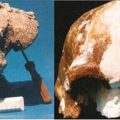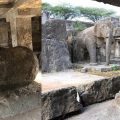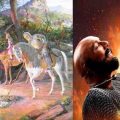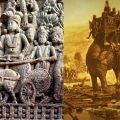Narmada: A Single Site for Indian History of Pre-Cambrian to Kaliyuga Period
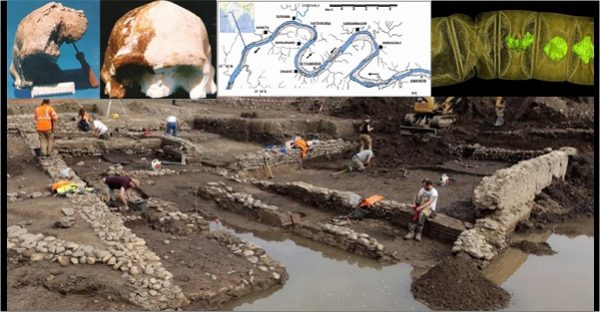
Narmada Valley is a national treasure where archaen age to the current age history can be found at one place and it should be preserved, celebrated and researched. Narmada basin extends over an area of 98796 Sq.km. and lies between east longitudes 72o 32′ to 81o 45′ and north latitudes 21o 20′ to 23o 45′ lying on the northern extremity of the Deccan Plateau. The basin covers large areas in the states of M.P., Gujarat and comparatively smaller areas in Maharashtra. Study of Narmada Basin is important because of its geographical location which is very strategic for migration of animal population from North to South and East to West. (N-S, E-W is quoted in Skanda Puran as well). Narmada was known to Ptolemy as Nammadus. Adi Shankara met his guru Govinda Bhagavatpada (भगवत्पन्द) on the banks of river Narmada.
One of the verses in Skanda Puran gives Puranic dates of River Narmada:
सप्तकल्पक्षये क्षीणे न मृता तेन नर्मदा ।
नर्मदैकैव राजेन्द्र ! परंतिष्ठेत्सरिद्वरा ॥५५॥
saptakalpakShaye kShiiNe na mR^itaa tena narmadaa .
narmadaikaiva raajendra paraMtiShThetsaridvaraa ..55.
“Seven Kalpas have passed, but that Narmada has not perished, Narmada is indeed the only one, O best of kings, the excellent river which has stayed beyond (the seven kalpas)”.
G. Dhanunjaya Naidu in his book Deep Crustal Structure of the Son-Narmada-Tapti Lineament, Central India provides information of #Narmada Origin. The book says the origin of Narmada valley is considered to be separated for two distinctly different periods; after beginning of eruption of Deccan trap and the period prior to it. Various geological studies hints that the zone of Narmada belong to early Precambrian. (As per modern Science, all life-forms were long assumed to have originated in the Cambrian, and therefore all earlier rocks were grouped together into the Precambrian. Although many varied forms of life evolved and were preserved extensively as fossil remains in Cambrian sedimentary rocks, detailed mapping and examination of Precambrian rocks on most continents have revealed that additional primitive life-forms existed as early as about 3.48 billion years ago. Nevertheless, the original terminology to distinguish Precambrian rocks from all younger rocks is still used for subdividing geologic time).
The Narmada-Son-Tapti lineament zone is believed to originated during middle to late archaen period. Skanda Puran also gives information that Narmada river came to earth 3 times during three different periods. The first one by King Hiranya Teja during first Satyug in Aadi (start) of Kalpa, 2nd unknown period, third by Chandravanshi king Pururva in Vaiswat Manvantar (MV).
Traditional Vedic time scale is cyclic in nature and follows 1000 Chaturyuga system in each Kalpa. Two Kalpas (8.64 billion years) is one night and day of Brahma. Brahma life cycle is 100 years (311.04 trillion years) which is known as PAR and half is called Paradhr. This is why in “Sankalpa Mantra” we use the term “dvitheeya parardhe” which means in the second half of Brahma’s life. It is amazing to see the deep meanings which are always hidden in many rituals. There are 14 Manus per MVs to rule one day of Brahma. Time duration of one MV is 71 Chaturyuga which means there are 71 Satyugs, 71 Treta, 71 Dwapar and 71 Kalyugs in each MV. We are currently in 28th Chaturyuga of 7th MV. Shiva used his Pinak Dhanush and Aghor named arrow from Shrishailya parvat to destroy tripur of Banasur. One part fell in Narmada and today that place is celebrated as Jaleshwar teerth.
Paleontology division of Geological Survey of India says fossilized human skull was found embedded in a conglomerate bed in Narmada valley. The bed occurs at a basal part of a formation sandwiched between two formation of 0.73 Ma and 74000 yrs before present (BP). The conglomerate bed has also preserved fossils of Hippopotamus namadicus, Equus namadicus, Stegodon namadicus, Sus namadicus, etc. having Middle Pleistocene affinity. All these stratigraphic and palaeontological evidences point to a Middle Pleistocene age (~12.5 lakhs year ago) of the Narmada Homo erectus skull.
Excavation in Narmada Valley
1) The excavation carried out by Shridhar Vakankar Archaeological Research Institute in Narmada valley Mehtakhedi village under Khargone district has led to the discovery of 350 archaeological remains which the experts claim to be 50,000 years old.
2) Human Fossil: In 1980s, former director of Geological Survey of India (paleontologist) Arun Sonakia had created a sensation surprising the world with his discovery of the “only human fossil skull in Asia” from near Hoshangabad in Central Narmada Valley Basin in Madhya Pradesh which he said was that of a homo erectus (predecessors of today’s human). “Study at Narmada Basin is important because of its geographical location which is very strategic for migration of animal population from North to South and East to West. It is not only rich in fossils and archaeological sites, but it has a long history of human occupation”. Kenneth Kennedy, an expert from Cornell University in the US who’s studied the skull, has suggested that it has more features of Homo sapiens than of Homo erectus. But GSI’s Sonakia believes that the skull is between 600,000 to 700,000 years old and represents Homo erectus.
3) Anthropological Survey of India – This modest beginning is a challenge for future since these human fossils have world-wide interest and implications in understanding human origins. It is also acclaimed by notable scholars, like Kenneth A. R. Kennedy, that India has enormous field resources for the palaeo-anthropological investigations where the Narmada basin and the Siwaliks are in particular of great significance.
4) Renowned historian SB Ota who has worked for the Archaeological Survey of India (ASI) has written that the Narmada valley is the only one that has precious remnants from the Palaeolithic age to the current age, at one place. His revealing findings, which were not favourable to the Government, were disregarded and even his research work was hampered by the Government which curtained funding. Some leftists historian went against him.
5) The 77 million year old dinosaurs fossil of Balasinor in village of Rahioli. Rahioli was a breeding ground for 13 species of dinosaurs; Rajasaurus species was known as king lizard of Narmada. The fossils of the same were found in Gujarat, Maharastra and Madhya Pradesh. Rajasauras has close resemblance to Majungatholus species of Madagascar. Prof. Mark Richards of University of California infers that 66 million years ago a powerful asteroid or striking of some powerful force in Mexico lead to volcanic eruption in western region of India and immense lava was produced. Another theory is due to Toba Ash. This lava today is known as deccan trap and covers 500,000 sq km. Extinction of dinosaurs may have been caused due to the same impact. Fossils are also found along Narmada river in Lodhai village (Gujarat), Dhar (MP). Volcanic ash near Bori industry of the Kukdi Valley in Pune is older than previously expected, dated by K–Ar to 1•4 ma (million years ago).
6) In 1990, Anthropological Survey of India published finds of two collar bones and a lower rib ‘ belonged to a woman who was between 25 and 35 years of age near Hathnora village in the Narmada region. This site was close to a site where palaeontologist Arun Sonakia from the Geological Survey of India (GSI) had discovered a skull in 1983. Prehistoric animals like Elephants (Steigodon), Buffaloes, Horses and Hippopotami were also found near the human bones in Hathnaura village of Sehore district. Anthropologists date the bones to 200000 to 500000 lakhs years. Near the confluence of Narmada and Lion river near Narsinghpur, the bone fossils of ancient animals have been found in huge quantities. Here, more than 5000 fossils of shark fishes have also been found.
7) In 1883, fossil of elephant was found by Capt. Sleeman in Jabalpur and a horse teeth were collected by G.G. Spillsbury in same year. In 1834, a giant buffalo was found by Spilsbury which gained shower of praises from Asiatic Society.
8) A femur bone assignable to a giant elephant (Elephas namadicus) has been excavated from the Surajkund Formation (-ca 0.5-0.7Ma) of the Narmada R. basin. Fossil femur of a giant elephant (cf. Elephas namadicus) from Middle Pleistocene, central India. The specimen is the largest femur so far reported from India. It has the greatest length of 1490 mm which suggests that the animal has attained estimated height of at least 4000 mm. Elephas namadicus, now extinct, is considered as a species that first appeared in Asia during Cromerian equivalent Pleistocene (-ca 0.5-0.7Ma). Fossil femur of a giant elephant (cf. Elephas namadicus) from Middle Pleistocene, central India.
9) Scientists have found a 67 million-year-old fossil of a snake coiled around dinosaur eggs and a hatchling. This is the first evidence of Snake Eating dinosaurs Sanajeh indicus. Geologist Dhanajay Mohabey of the Indian Geological Survey first unearthed the fossil 26 years ago in a rocky, limestone outcropping in the northwestern Indian village of Dholi Dungri in Gujarat. The newly discovered species of snake, Sanajeh indicus, measures about 11.5 feet long. The hatchlings, part of a group called titanosaurs, measured about a foot and a half long. Titanosaurs were the largest animal to ever walk on land, with adults that could reach up to 100 feet long.
10) A study published in the journal PLOS Biology has noted that fossils of a particular kind of plant algae have been unearthed in Chitrakoot, India, and are 1.6 billion years old. This would essentially make these fossils the earliest-known plants on this planet. By Chitrakoot, there is Chitrakoot falls which is located in the middle of Vindhya ranges. The waterfall is formed by the Indravati River in Chattisgarh region which is a tributary of Narmada. The fossils found, according to this study, belong to two types of red algae. Science has placed the beginning of multi-cellular organisms at 600 million years ago, the earliest signs of life (in the form of single-celled organisms) goes back 3.5 billion years.
The evolution of Deccan basalts in western & central India is also associated with rapid drifting of approx. 15-20 cm per year of the Indian plate during cretaceous-Tertiary period (67-64 Ma).
Puranic History of Narmada
Pururva and Narmada in Vaiswat Manavantar: Vaiswat Manav-antar is the 7th manavantar among 6 passed and 7 more to come. Current one is Varah Kalpa. The manu in this manavantar was Vaiswat. One of the 1st Manu named Swambhu’s son had three sons Uttam, Raivat & Tamas who became Manus of 3rd, 4th and 5th Manavantar. The 2nd Manu was Swarochi . After every manavantar the earth is flooded with water and one great king from past Manavantar gets responsibility to take pair of each species to next Manavantar.
Satyavrat at the end of 6th Manavanatar when Matsya avatar took place where he was advised to build a big ship, and got responsibility to take a pair of all species to next manavantar and he became Manu of Vaiswat, the 7th Manavanatar. He is also known as Shraddhadev because he got married to Shraddha Devi. The ship was tied by means of Nagraj Vasuki to horns of the Matsya. The flood in 6th Manavantar was caused by seven types of cloud named Samvarta, Bhimananda, Drona, Chanda, Valahaka, Vidyutapataka and Kona. Then he started populating the world. Ikshvaku, Drisht, Sharyati, Narishyanta, Nabhag, Disht, Karush, Prishadhra, Vasumana, Dharmgya and Sudyumna/Ila were sons of 7th Manu. Iskavaku gave rise to Suryvanshaand Sudhymna/Ila started Chandravanshis.
From Ila and Budhh (son of Chandrama), Pururva was born. From Pururva came Ayu and from Ayu came Nahusa and other four brothers Kṣatravṛddha, Rajī, Rabha and Anenā. From Kṣatravṛddha came Kasya, Kuśa and Gṛtsamada. From Kasya came Kasi. From Gṛtsamada came Śunaka, and from him came the great sage Śaunaka. From Nahusa came King Yayati whose sons were Yadu, Turvasau, Dhurhyu, Anu and Puru. Druhyu and Anus migration are still been discussed by various scholar till date.
Rewa Khand of Skanda Puran gives information about River Narmada. A total of 90 pages are dedicated in the glory of Narmada. The conversation between Yudhistr and Marknde Rshi gives information of origin of River Narmada during Pururva and other times. At times of Chndrvnshi King Pururva, Narmada was brought to earth by his immense efforts by the blessings of Shiva on Jambudweep. At that time, Jambudweep was of one lakh yojan. The Paryank giri (पर्यंक) took responsibility as base on which the intense flow of Narmada will fall. Paryank mountain (eldest Manas Putr of Vindhya) is same place where in olden times (in Chakshuk Manavantar) King Prthu did Ashwamedh yagy. Narmada is daughter of Maikal. There is an interesting story of Narmada, Son worth reading. Narmada is daughter of Maikal Hills emerged from Shiv, and source on earth is said to be Amarkantak. The band ‘Indian Ocean’ dedicated a track named “Ma Rewa” for Narmada river.
Hiranya Teja & Narmada: Rewa Khand talks about one more Chandravanshi king Hiranya Teja who is credited to bring Narmada on earth. He did intense tpsya of Lord Shiv from a legendary mountain named Udayanchal. This time Udayanchal parvat was the base where river started flowing from. Her flow was so intense that further three more mountains Meru, Himvan and Kailash were formed supported by vindhya mountains. The length of these parvat from east to west was 32000 yojan and breadth from South to north was 500 yojans. It is said that Narmada has 150 srotra.
In north of Narmada is Anantpur where some of the famous Rshis like Savarni, Kaushik, Saakalya, Agnigarbha etc have lived. Anantpur is the place where Iskvaku, Kuwalyashv, Dilip, Nahush, Yayati, Ajpaal, Haiheya have lived for sometime. Narmada has long history of various dharmic activites done by number of ancient people with number of teerths like Kapila Teerth, tripuri teerth of 108 shivling (a place where Tripur was killed). As per Mastya and Padam Puran there were 10 crore ghats. As per Agni and Kurm Puran 60 crores. Many kingdom came and went on bank of Narmda, one such notable kingdom was Krtavir Arjuna who ruled at Mahismati. Later Parshuram ended him.
Manu and Narmada: Manu did a great yagya on the banks of Narmada with a wish to have rivers in Ayodhya. Then Narmada gave boon to Manu that a great king Bhagiratha will bring Ganga on earth in first part of Treta. During 2nd part of Treta Kalindi, Saraswati, Saryu, Mahabhaga etc river will come on earth.
Kartaviry, Jamdgni, Parshuram, Kaamdhenu and Narmadapur: At north bank of Narmada, towards west of Kapilasangam there is a place called Narmadapur where Jamdagni Rshi used to live. He had Gaumata named Kamdhenu. Once King Kaartavirya Arjun of Mahismati came there and took Kamdhenu by force after killing Jamdagni rshi. Kamdhenu got a cruel treatment and Gaumata cursed Kartaavirya that son of Renuka, Parshuram will end your entire lineage and same thing happened. Devdroni is famous place for Pinddaan for pitar. Lakhs of teerths are associated with Narmada River.
“Narmada river is one place to find all answer towards the great ancient Bhartiya history”, we suggest government to set a dedicated National Institute of Paleontology and give more focus to Narmada studies”
Ref:
1] Skanda Puran
2] http://www.hindustantimes.com/…/story-z7nQYgxard3jP0DzS4fLJ…
3] Deep Crustal Structure of the Son-Narmada-Tapti Lineament, Central India: By G. Dhanunjaya Naidu
4] https://www.telegraphindia.com/…/…/knowhow/story_4481256.asp
5] https://m.dailyhunt.in/…/narmada+the+oldest+one+river+of+in…
6] https://journals.lib.washington.edu/…/a…/viewFile/11291/9931
7] https://www.researchgate.net/…/288736820_Fossil_femur_of_a_…
8] http://www.rhinoresourcecenter.com/pdf_fil…/…/1249821154.pdf
9] “Predation upon Hatchling Dinosaurs by a New Snake from the Late Cretaceous of India,”/Jeffrey A. Wilson, Dhananjay M. Mohabey, Shanan E. Peters, Jason J. Head/Public Library of Science Biology, Mar. 2010, Vol. 8, Issue 3.
10] http://www.hindustantimes.com/…/story-17WT2JkLzuVUxprrR660i…
Featured image courtesy: artasaweapon.info, Hindustan Times, Down to Earth, ResearchGate.
Disclaimer: The views expressed here are solely of the author. My India My Glory does not assume any responsibility for the validity or information shared in this article by the author.

